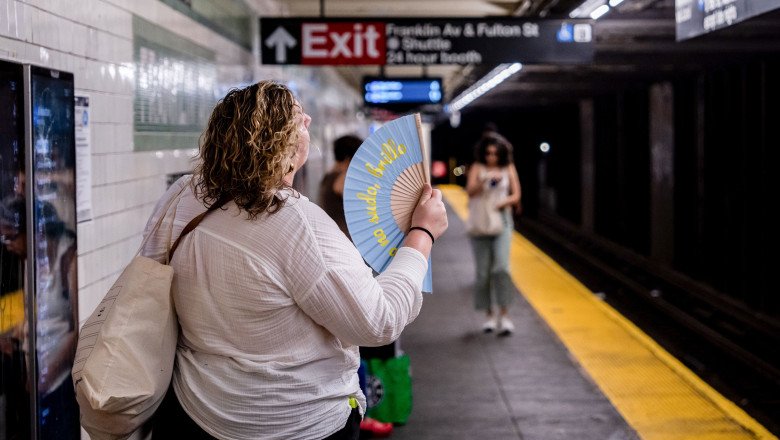
views
This week, blistering temperatures could put more than 220 million Americans at risk. Extreme heat is the deadliest type of weather disaster in the United States—and one of the most underestimated. In my decades of climate resilience work in towns and neighborhoods, I’ve seen firsthand the pain, loss, and economic costs of extreme heat. Heat strains power grids, damages infrastructure, and worsens air pollution. It puts outdoor and commuting workers at risk, flares chronic health conditions, profoundly endangers mother and baby during pregnancy, and disproportionately harms children, older adults, and low-income families.
Advertisement
Advertisement
Yet as communities from the Eastern Seaboard to the Midwest are engulfed in record-breaking temperatures, the U.S. is now even more dangerously unprepared. The safety net we count on in moments of climate crisis isn’t just fraying—it’s unraveling. As a result, you are (or will soon be) forced to become your own first responder.
In its drive to slash the size and scope of the federal government, the Trump administration has weakened the very agencies and systems we rely on to prepare for and respond to disasters–including extreme heat. Cuts to NOAA’s forecasting programs weaken our ability to anticipate and plan for dangerously high temperatures while reduced support for programs like the Low-Income Home Energy Assistance Program (LIHEAP) and slashed funding for public health efforts—like the CDC’s Climate and Health Program—leave states and cities without tools to protect residents before and during heat waves.
Advertisement
Read More: Losing NOAA’s Natural Disaster Data Will Make Storms More Devastating for the Poor
While these cuts may seem abstract or bureaucratic, their impact is personal. If you’ve ever checked the weather on your phone, you’ve depended on NOAA. These are the scientists who issue early warnings that save lives. When funding is slashed, those alerts may come too late—or not at all.
Even before summer officially began, Americans were grappling with the impacts—from International Falls, Minnesota, known as the “icebox of the nation,” where temperatures soared into the 90s in early May, to the Rio Grande Valley, which endured a mid-May heatwave that made it hotter than Death Valley. Alaska—yes, Alaska—issued its first ever heat warning this week.
Read More: The Most Efficient Way to Run Your AC During a Heat Wave
While the administration claims it is shifting responsibility to the states, this blatantly ignores the reality that states lack the funding and infrastructure to manage on their own. Federal grants have been essential to states’ preparedness. Even cities widely regarded as leaders in disaster preparedness are strained. Miami-Dade County was forced to eliminate both its Chief Resilience Officer and Chief Heat Officer roles due to budget constraints, while Los Angeles’ proposed budget would eliminate its entire climate resilience office.
Advertisement
I work with under-served communities around the world, from the United States to India, and Mexico to Greece. I’ve sat in community centers where mothers have shared strategies on how to stay safe working outdoors while still earning enough to feed their families. I’ve walked through Sierra Leone outdoor markets and seen the benefit of simple shade structures to prevent heat stroke. These efforts are survival.
When governments can’t (or won’t) help us, we—our communities—become the first line of defense. As a first responder, here’s what you can do:
It’s important to understand your local climate threats. Arm yourself with information on the early signs of heat illness: dizziness, headache, nausea, rapid heartbeat, and confusion. Heatstroke is a medical emergency that requires immediate action. Awareness saves lives and sparks action.
Heat doesn’t just affect “other people”—healthy, young individuals are now showing up in emergency rooms. Having a plan can save lives. That means staying hydrated, resting in shade or air-conditioned spaces, and scheduling strenuous outdoor activities early in the day. If you don’t have air conditioning, know where the nearest cooling center is and how to keep your home cooler—by closing blinds during the day and using fans or cross-ventilation at night, when staying cool is essential for the body to rest and recover.
Advertisement
Loneliness can be lethal during a heatwave. Programs like Philadelphia’s Heat Response Program and Los Angeles’ senior outreach initiative show how check-ins save lives. But you don’t need a government job to do this. Create a phone tree or a group chat. Encourage people to “adopt a neighbor” during heat alerts. One call can make all the difference.
When government systems falter, schools, libraries, religious institutions, and shaded parks can become heat-safe hubs. I’ve helped cities pilot community cooling spaces that serve as a refuge for people without access to air conditioning and seen how, when designed thoughtfully, cooling centers are not just places to retreat—they are places to reconnect, reorganize, and rebuild.
While your new job as a first responder is critical, it’s not yours to keep — that’s the government’s. Until then, however, and while the safety net is burning, it’s on us to help put out the flames.
https://time.com/7297209/extreme-heat-first-responder-community-essay/






















Comments
0 comment